NPB: Respiration 1
1/150
Earn XP
Description and Tags
Name | Mastery | Learn | Test | Matching | Spaced |
|---|
No study sessions yet.
151 Terms
MCQs: Definitions
5. What is internal respiration?
A. The exchange of gases in the lungs
B. Transport of oxygen in the blood
C. Cellular respiration involving mitochondria
D. Movement of air through the trachea
C. Cellular respiration involving mitochondria
where oxygen is used to produce ATP from glucose.
Which of the following best describes external respiration?
A. Breakdown of glucose within the cell
B. Gas exchange between blood and body cells
C. Gas exchange involving lungs, air passages, thoracic muscles, and cardiovascular system
D. Diffusion of ions across the plasma membrane
C. Gas exchange involving lungs, air passages, thoracic muscles, and cardiovascular/circulatory system
processes that bring oxygen into the lungs and deliver it to the bloodstream
In which part of the body do the partial pressures of O₂ and CO₂ need to be tightly regulated?
A. Venous blood
B. Arterial blood
C. Lymphatic fluid
D. Digestive system
B. Arterial blood
Systemic arterial blood carries oxygen to tissues, so maintaining proper PO₂ and PCO₂ levels here is critical for efficient gas exchange and cellular function.
MCQs: Functions of Respiration
Which of the following is a major function of the respiratory system?
A. Production of white blood cells
B. Regulation of glucose homeostasis
C. Regulation of partial pressures of O₂ and CO₂ in the blood
D. Filtration of plasma proteins
C. Regulation of partial pressures of O₂ and CO₂ in the blood
The respiratory system helps maintain homeostasis by regulating these partial pressures
In addition to gas exchange, what else does the respiratory system help regulate to maintain homeostasis?
A. Glucose absorption
B. Blood pH
C. Enzyme activity
D. Vitamin D synthesis
B. Blood pH
What is another role of respiration beyond regulating gases and pH?
A. Body temperature homeostasis
B. Breakdown of proteins
C. Direct control of blood pressure
D. Calcium storage
A. Body temperature homeostasis
What role does the respiratory system play in communication?
A. Enhances auditory function
B. Supports vocalization by controlling airflow
C. Adjusts vocal cord length for swallowing
D. Prevents vibration of vocal cords
B. Supports vocalization by controlling airflow
What does the term homeostatically refer to in the context of respiratory function?
A. Random fluctuations in gas levels
B. Temporary control of hormones
C. Maintaining internal balance of blood gases
D. Involuntary muscle twitches
C. Maintaining internal balance of blood gases
MCQs: Internal (Cellular) Respiration
Which organelle is responsible for internal respiration (cellular respiration)?
A. Golgi apparatus
B. Ribosome
C. Mitochondrion
D. Nucleus
C. Mitochondrion
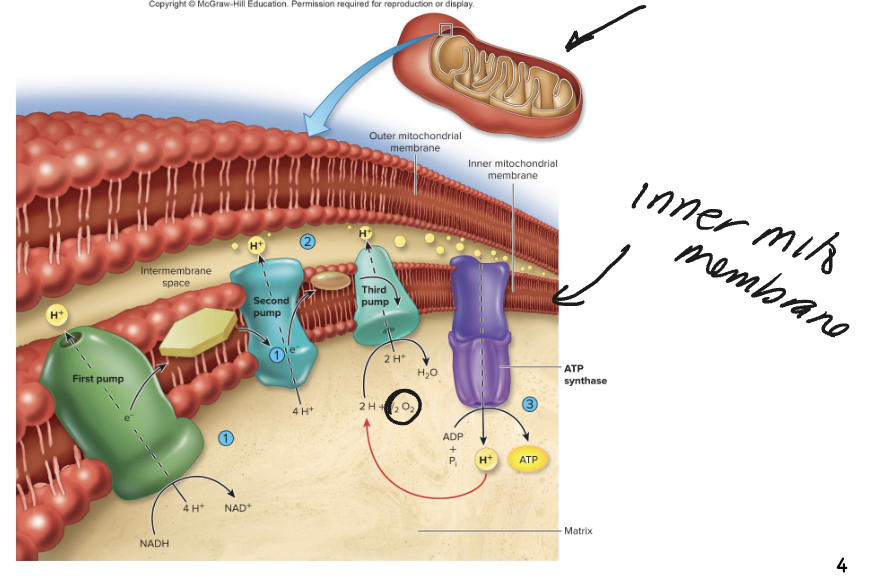
What structure within the mitochondrion houses the electron transport enzymes?
A. Cristae fluid
B. Mitochondrial matrix
C. Outer mitochondrial membrane
D. Inner mitochondrial membrane
D. Inner mitochondrial membrane
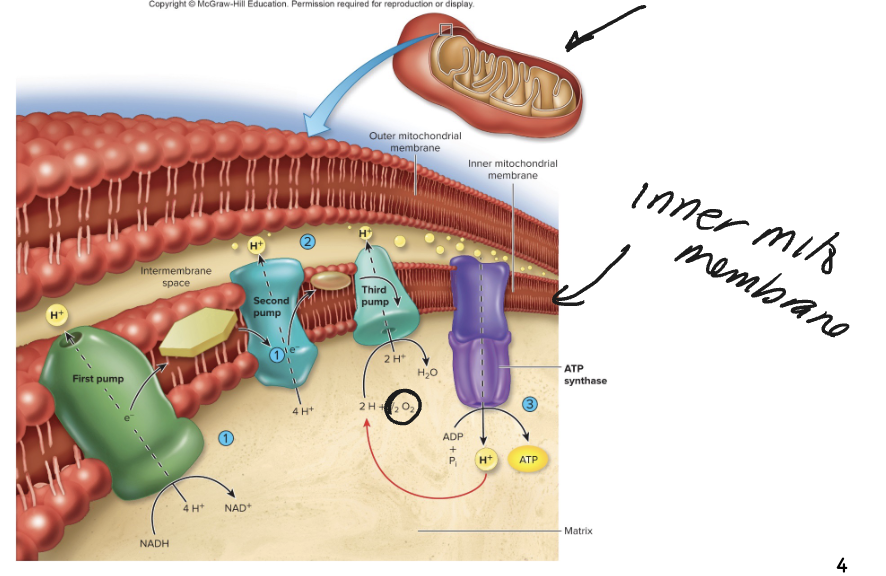
What is the byproduct of oxygen consumption during internal respiration?
A. ATP
B. Carbon dioxide
C. Water
D. Pyruvate
C. Water
Where is carbon dioxide generated during cellular respiration?
A. Electron transport chain
B. ATP synthase
C. Glycolysis and the TCA cycle
D. Mitochondrial intermembrane space
C. Glycolysis and the TCA cycle
MCQs – External Respiration
1. What is the primary function of external respiration?
A. ATP synthesis in the mitochondria
B. Gas exchange between the alveoli and pulmonary capillaries
C. Transport of nutrients to cells
D. Breakdown of glucose
B. Gas exchange between the alveoli and pulmonary capillaries
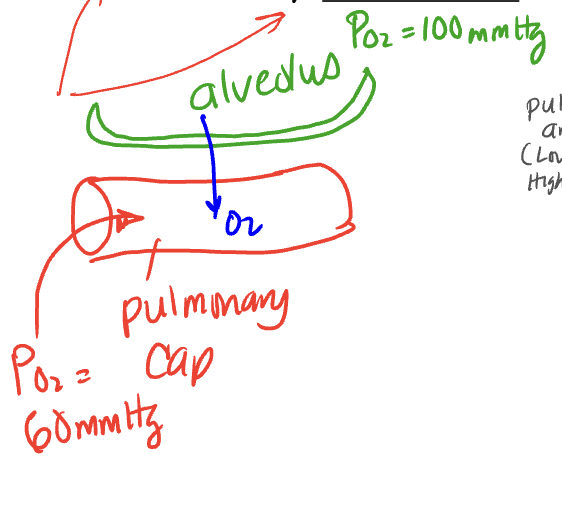
What drives the diffusion of gases during external respiration?
A. Active transport
B. Temperature gradients
C. Electrical charge
D. Partial pressure gradients
D. Partial pressure gradients
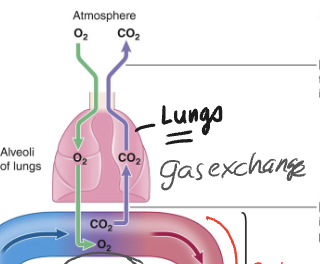
During gas exchange in the lungs, which direction do the gases move?
A. O₂ enters blood; CO₂ stays in alveoli
B. CO₂ enters blood; O₂ enters alveoli
C. O₂ enters blood; CO₂ leaves blood into alveoli
D. O₂ and CO₂ both leave the blood
C. O₂ enters blood; CO₂ leaves blood into alveoli
What is true about oxygenated blood?
A. It is found in the pulmonary artery
B. It contains high levels of carbon dioxide
C. It is bright red and rich in oxygen
D. It only exists in the right side of the heart
C. It is bright red and rich in oxygen
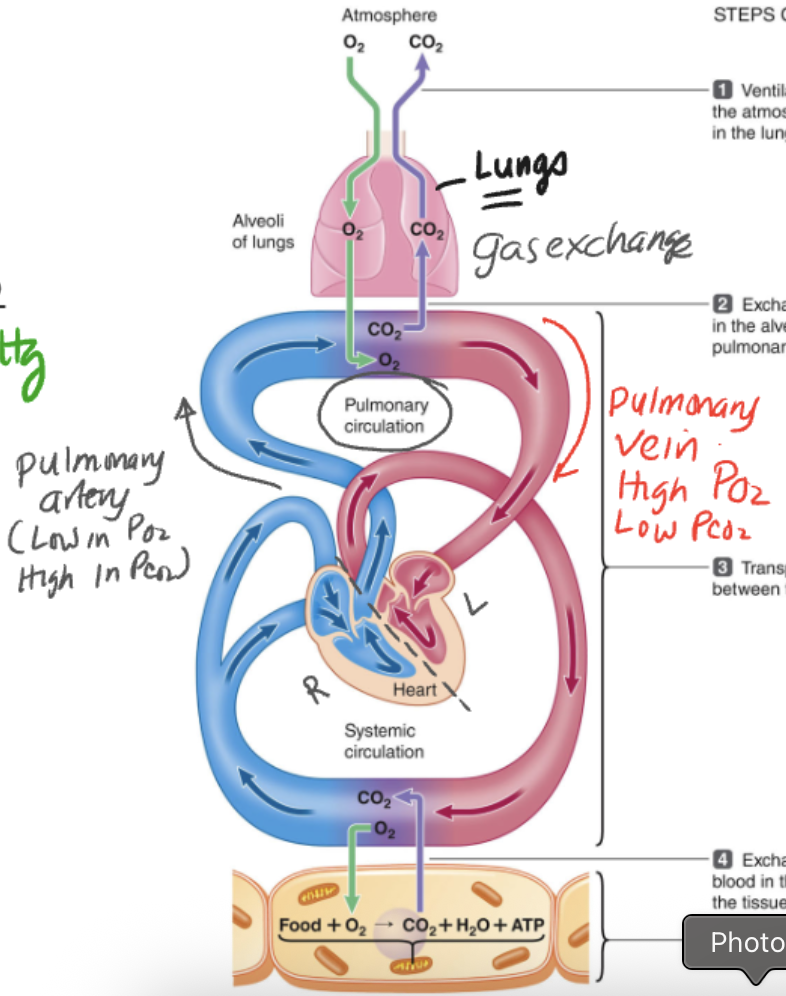
Which of the following vessels carries oxygenated blood?
A. Pulmonary artery
B. Inferior vena cava
C. Pulmonary vein
D. Right atrium
C. Pulmonary vein
What is true about deoxygenated blood?
A. It has already passed through the lungs
B. It contains a high concentration of oxygen
C. It is bright red
D. It contains more carbon dioxide than oxygen
D. It contains more carbon dioxide than oxygen
low O₂ and high CO₂ and is sent to the lungs to get rid of CO₂ and pick up fresh O₂.
Which blood vessel carries deoxygenated blood to the lungs?
A. Pulmonary vein
B. Pulmonary artery
C. Aorta
D. Left ventricle
B. Pulmonary artery
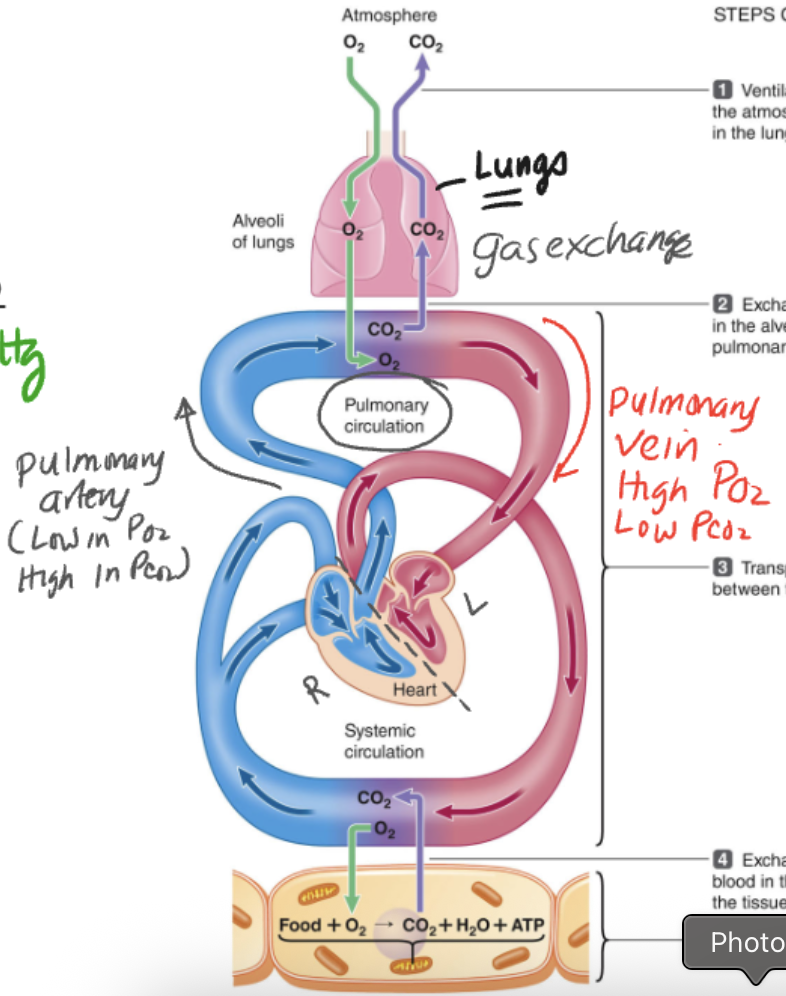
Which blood vessel carries oxygenated blood away from the lungs?
A. Pulmonary artery
B. Pulmonary vein
C. Inferior vena cava
D. Bronchial artery
B. Pulmonary vein
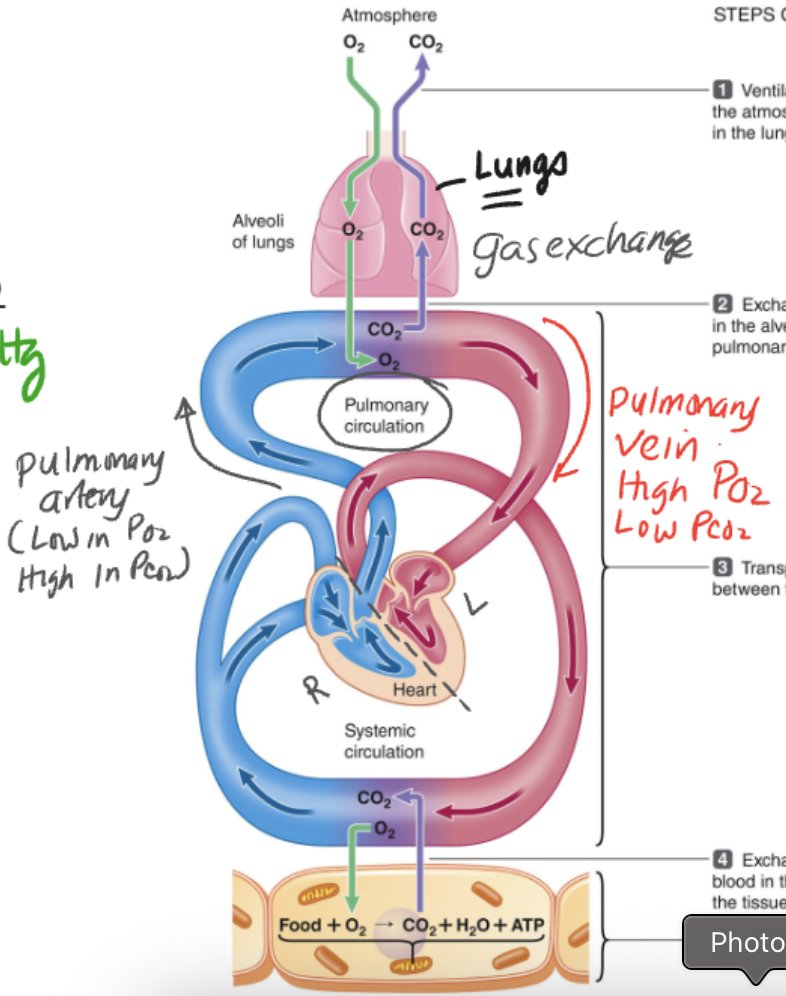
Which blood vessel delivers deoxygenated blood containing carbon dioxide to the lungs?
A. Pulmonary vein
B. Systemic artery
C. Pulmonary artery
D. Coronary artery
C. Pulmonary artery
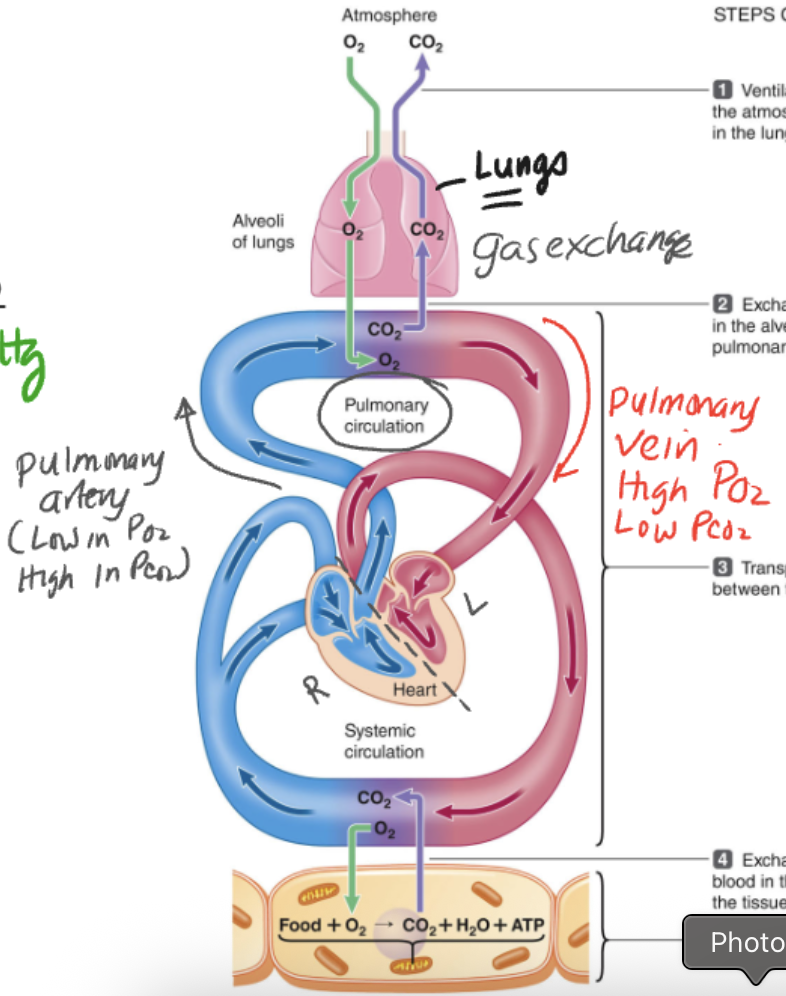
In the alveoli, the partial pressure of oxygen (P_O₂) is approximately:
A. 40 mmHg
B. 60 mmHg
C. 100 mmHg
D. 160 mmHg
C. 100 mmHg
In the pulmonary capillaries arriving from the pulmonary artery, P_O₂ is approximately:
A. 0 mmHg
B. 20 mmHg
C. 60 mmHg
D. 100 mmHg
C. 60 mmHg
What happens to the levels of oxygen and carbon dioxide in the pulmonary vein after gas exchange?
A. Low P_O₂, High P_CO₂
B. High P_O₂, Low P_CO₂
C. Low P_O₂, Low P_CO₂
D. High P_O₂, High P_CO₂
B. High P_O₂, Low P_CO₂
What equation describes the relationship between blood flow, pressure, and resistance in the respiratory system?
A. Blood Flow = ΔP / Resistance
B. Blood Flow = Resistance × Pressure
C. Blood Flow = ΔV / ΔP
D. Blood Flow = Pressure – Volume
A. Blood Flow = ΔP / Resistance
MCQs – Conducting Zone of the Respiratory System
1. What is the main function of the conducting zone in the respiratory system?
A. Exchange of gases with blood
B. Creation of red blood cells
C. Movement of air into and out of the lungs
D. Storage of oxygen
C. Movement of air into and out of the lungs
What is the correct order in which air flows through the conducting zone?
A. Trachea → Mouth → Alveoli
B. Nasal/oral cavity → Trachea → Bronchi → Bronchioles
C. Bronchi → Bronchioles → Pharynx → Larynx
D. Alveoli → Bronchi → Trachea
B. Nasal/oral cavity → Trachea → Bronchi → Bronchioles
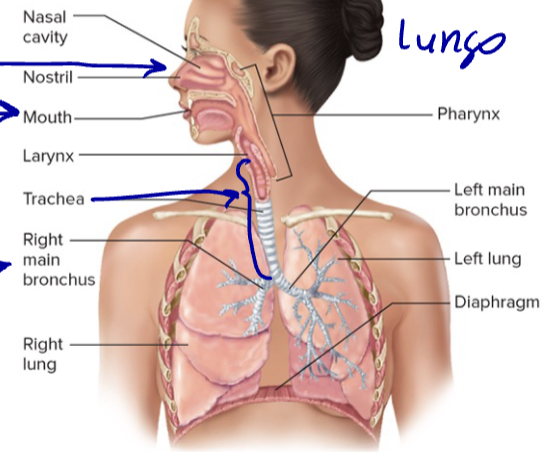
Which of the following is not a function of the conducting zone?
A. Warming and humidifying air
B. Gas exchange with capillaries
C. Filtering out particulates
D. Constriction and dilation of airways
B. Gas exchange with capillaries
Which structure is part of the conducting zone?
A. Alveolus
B. Right atrium
C. Trachea
D. Pulmonary vein
C. Trachea
What helps prevent foreign particles from reaching the lungs during breathing?
A. Mitochondria
B. Capillaries
C. Conducting zone filtering
D. Diaphragm contraction
C. Conducting zone filtering
MCQs – Respiratory Branching & Zones
What structure helps prevent larger airways like the trachea and bronchi from collapsing during breathing?
A. Smooth muscle
B. Mucus
C. Cartilage
D. Cilia
C. Cartilage
What happens to cartilage as the airways reach the bronchioles?
A. It increases in thickness
B. It becomes flexible cartilage
C. It is no longer present
D. It becomes bone-like
C. It is no longer present
What happens to the diameter of the airways as they branch deeper into the conducting zone?
A. The airways increase in diameter
B. The diameter stays the same throughout
C. The airways collapse completely
D. The airways become smaller in diameter
D. The airways become smaller in diameter
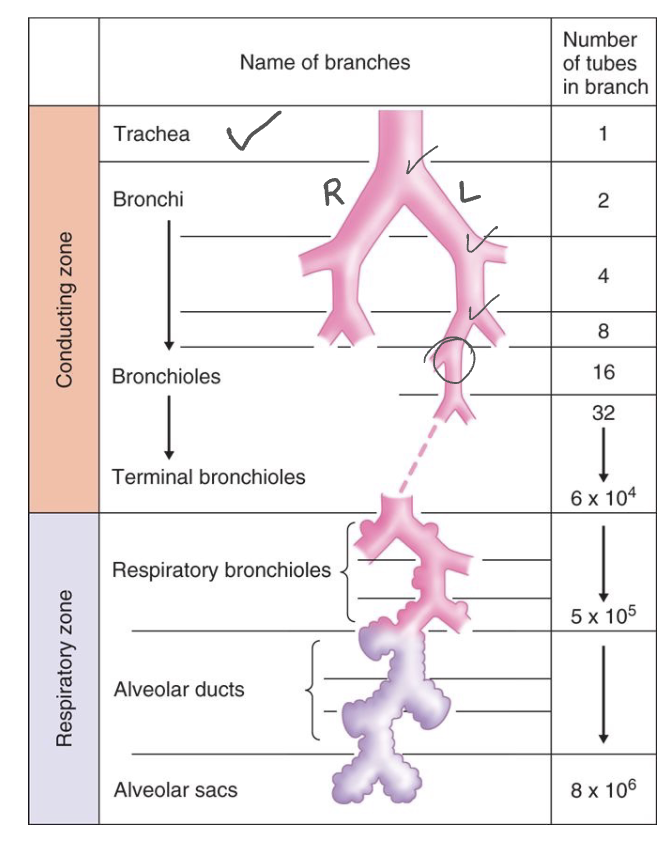
Which structure appears after the 4th to 5th division in the airway branching?
A. Trachea
B. Bronchi
C. Bronchioles
D. Alveoli
C. Bronchioles
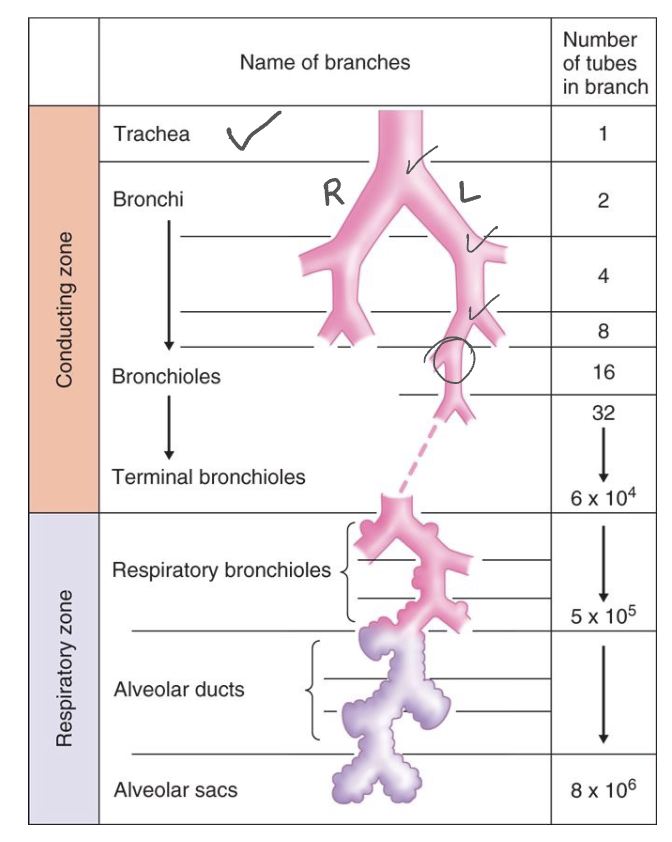
Around which airway generation does the respiratory zone begin?
A. 1
B. 4–5
C. 10
D. 16
D. 16
Which part of the respiratory system is the first to participate in gas exchange?
A. Terminal bronchioles
B. Trachea
C. Respiratory bronchioles
D. Bronchi
C. Respiratory bronchioles
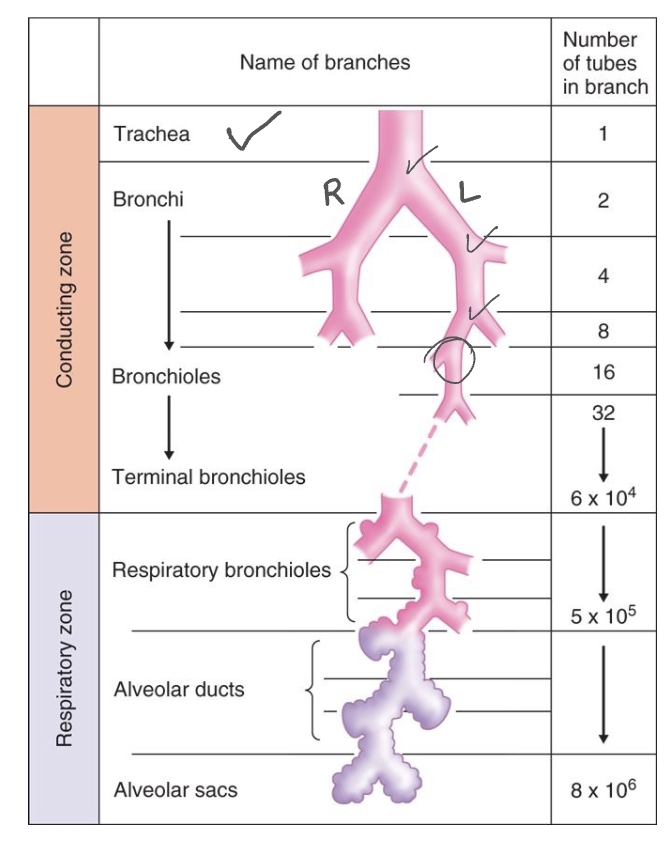
Which of the following structures is part of the conducting zone?
A. Alveolar ducts
B. Bronchi
C. Alveolar sacs
D. Respiratory bronchioles
B. Bronchi
What is the main purpose of the respiratory zone?
A. Filtering and humidifying air
B. Conduction of air to the throat
C. Exchange of O₂ and CO₂
D. Producing mucus
C. Exchange of O₂ and CO₂
MCQs – The Respiratory Zone & Alveoli
What is the primary function of all structures within the respiratory zone?
A. Filtering and humidifying air
B. Generating mucus and moving it with cilia
C. Exchanging gases between air and blood
D. Preventing airway collapse during exhalation
C. Exchanging gases between air and blood
What makes respiratory bronchioles unique compared to other bronchioles?
A. They produce surfactant
B. They are part of the conducting zone
C. They carry blood to alveoli
D. They are the first airway structures where gas exchange begins
D. They are the first airway structures where gas exchange begins
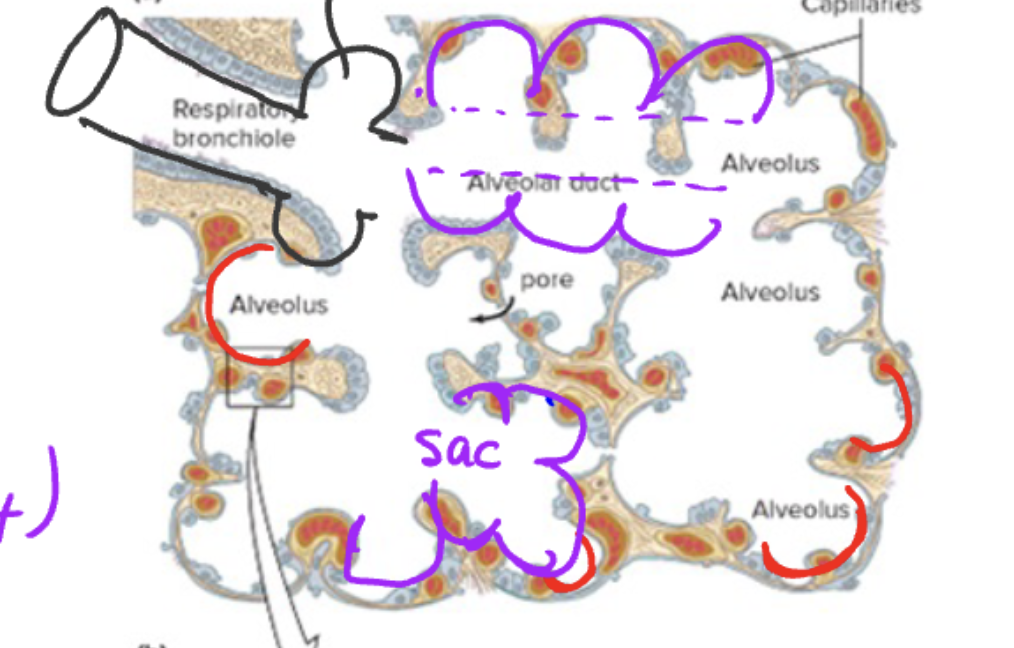
1. What is the major site of gas exchange between the atmosphere and the blood?
A. Bronchi
B. Bronchioles
C. Trachea
D. Alveoli
D. Alveoli
How many alveoli typically connect directly to a respiratory bronchiole?
A. 5–10
B. 3–4
C. 1–2
D. 0 – they only connect to alveolar sacs
C. 1–2
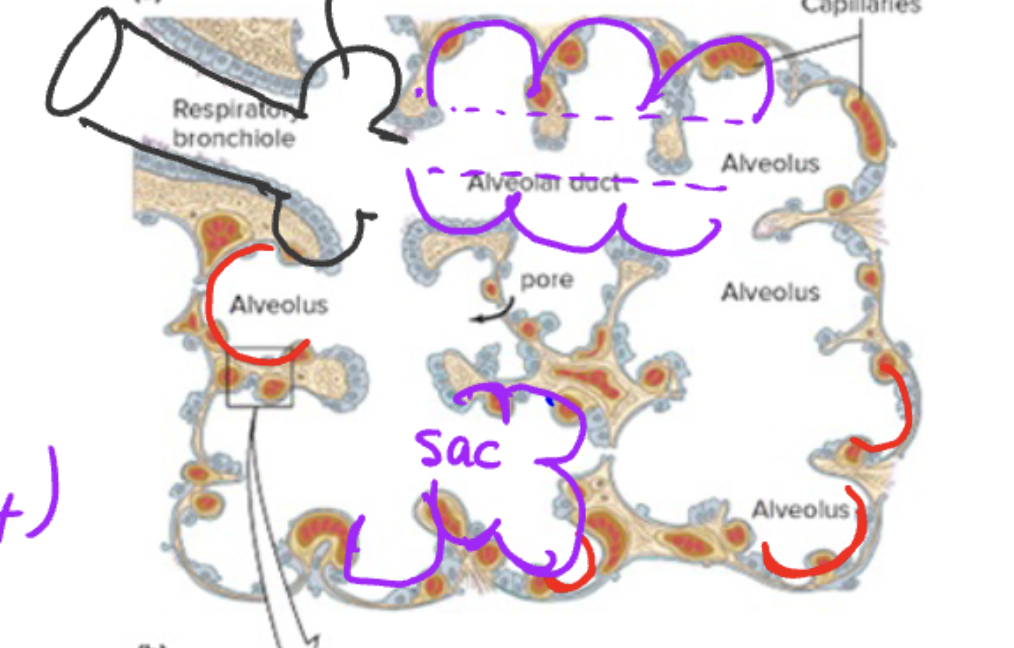

What is the function of pulmonary capillaries surrounding the alveoli?
A. To allow exchange of oxygen and carbon dioxide with alveoli
B. To support airflow between bronchioles
C. To move mucus into the alveoli
D. To generate surfactant for alveolar stability
A. To allow exchange of oxygen and carbon dioxide with alveoli
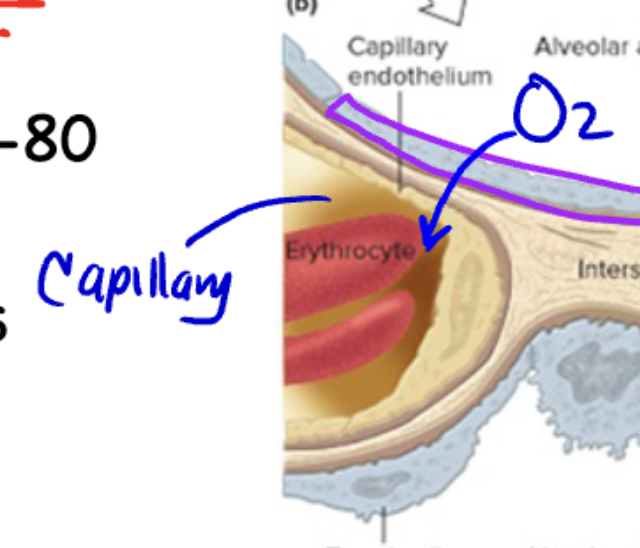
What is the role of alveolar ducts in the respiratory system?
A. They filter and humidify incoming air
B. They transport air but do not participate in gas exchange
C. They are narrow passages that lead to alveolar sacs and participate in gas exchange
D. They produce mucus to trap particles
C. They are narrow passages that lead to alveolar sacs and participate in gas exchange
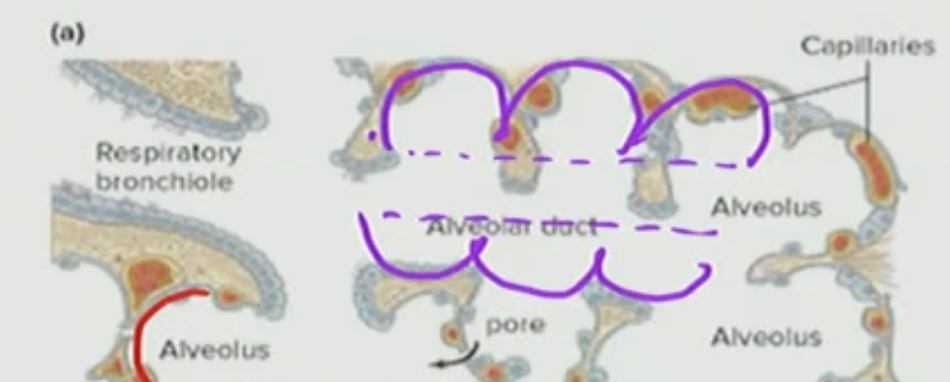
What do multiple alveoli grouped together form?
A. Bronchiole
B. Alveolar duct
C. Respiratory bronchiole
D. Alveolar sac
D. Alveolar sac

What type of epithelial cell makes up most of the alveolar wall and is responsible for gas exchange?
A. Type II alveolar cell
B. Ciliated epithelial cell
C. Type I alveolar cell
D. Goblet cell
C. Type I alveolar cell
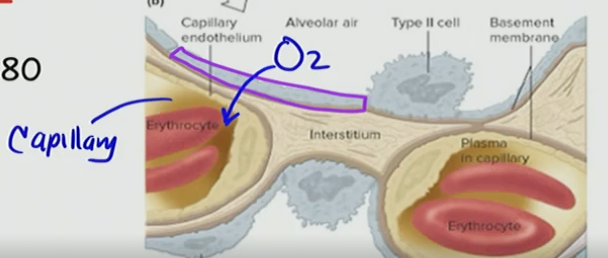
Why is gas exchange efficient in the alveoli?
A. Alveoli are filled with blood
B. Diffusional distance is long
C. They contain cilia and mucus
D. Diffusional distance is short and surface area is large
D. Diffusional distance is short and surface area is large
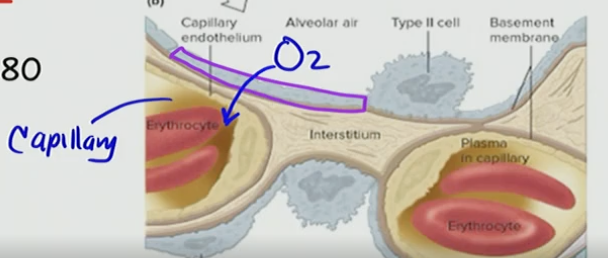
T/F: For diffusion, you want the distance to be thick and long
False, for diffusion you need a short distance and for it to be flat
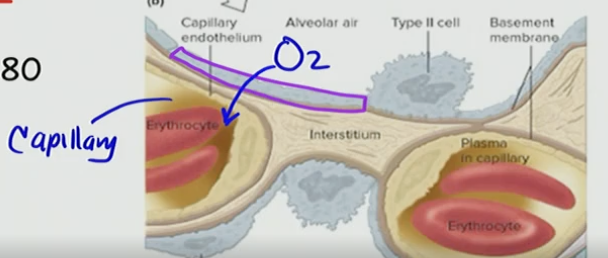
Which structures are part of the respiratory zone? (Select the most complete answer)
A. Respiratory bronchioles, alveolar ducts, alveolar sacs
B. Bronchioles, terminal bronchioles
C. Trachea, bronchi, bronchioles
D. Mouth, pharynx, trachea
A. Respiratory bronchioles, alveolar ducts, alveolar sacs
Which of the following best describes the relationship between alveoli and capillaries?
A. Alveoli are distant from capillaries
B. Capillaries wrap around alveoli to allow gas exchange
C. Capillaries are only found in conducting airways
D. Capillaries only carry lymph near alveoli
B. Capillaries wrap around alveoli to allow gas exchange
creating a close interface for O₂ and CO₂ to rapidly diffuse between air and blood
Respiratory Muscles
What is normal inspiration?
A. The total volume of air the lungs can hold during maximal inhalation
B. Passive breathing that involves contraction of the diaphragm and external intercostal muscles
C. Breathing that only uses accessory muscles like the scalenes
D. Expelling air from the lungs by contracting abdominal muscles
B. Passive breathing that involves contraction of the diaphragm and external intercostal muscles
Which muscles are primarily used during normal (quiet) inspiration?
A. Diaphragm and abdominal muscles
B. Sternocleidomastoids and scalenes
C. Diaphragm and external intercostal muscles
D. Internal intercostal muscles and scalenes
C. Diaphragm and external intercostal muscles
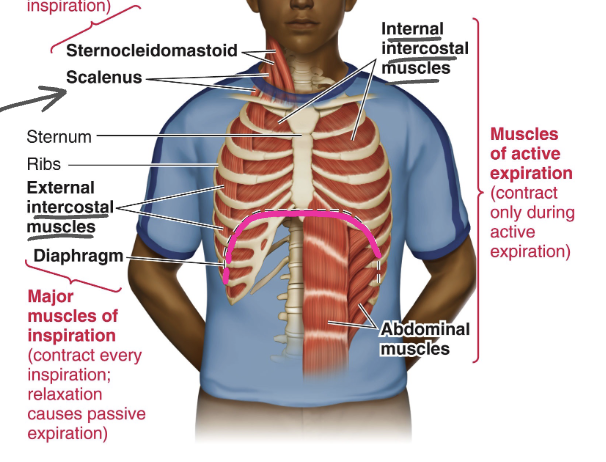
What is the approximate tidal volume during normal breathing?
A. ~250 mL
B. ~500 mL
C. ~1,000 mL
D. ~2,000 mL
B. ~500 mL
What volume of air is typically moved during normal inspiration (tidal volume)?
A. ~200 mL
B. ~350 mL
C. ~500 mL
D. ~1000 mL
C. ~500 mL
What is the best definition of tidal volume?
A. The maximum amount of air that can be forcibly exhaled after a deep breath
B. The amount of air inhaled or exhaled during normal, quiet breathing
C. The amount of air remaining in the lungs after expiration
D. The total volume of air the lungs can hold
B. The amount of air inhaled or exhaled during normal, quiet breathing
What is forced respiration?
A. Breathing that occurs only during sleep
B. Automatic breathing controlled by the brainstem
C. Deep or active breathing using additional muscles beyond normal inspiration or expiration
D. Relaxation of all respiratory muscles to stop airflow
C. Deep or active breathing using additional muscles beyond normal inspiration or expiration
Which muscles are recruited during forced inspiration?
A. Diaphragm and internal intercostals
B. Sternocleidomastoid and scalenes
C. Abdominal and external intercostals
D. Diaphragm and abdominal muscles
B. Sternocleidomastoid and scalenes
What is forced expiration?
A. Passive relaxation of the diaphragm
B. Active exhalation using muscles to push air out more forcefully
C. The movement of air into the lungs during normal breathing
D. Contraction of the external intercostals and diaphragm
B. Active exhalation using muscles to push air out more forcefully
Which muscles are involved in forced expiration, such as during coughing or blowing out air forcefully?
A. Diaphragm and external intercostals
B. Internal intercostals and abdominal muscles
C. Sternocleidomastoids and scalenes
D. External intercostals only
B. Internal intercostals and abdominal muscles
What do normal inspiration and forced inspiration have in common?
A. Both only involve accessory muscles
B. Both require contraction of the diaphragm and external intercostal muscles
C. Both involve relaxation of all respiratory muscles
D. Both rely solely on abdominal muscles
B. Both require contraction of the diaphragm and external intercostal muscles
How is normal expiration accomplished?
A. By active contraction of internal intercostals
B. By contracting the diaphragm
C. By relaxing the diaphragm and external intercostals
D. By contracting abdominal muscles
C. By relaxing the diaphragm and external intercostals
During forced inspiration, are the diaphragm and external intercostals still active?
A. No, they shut off
B. Yes, but they switch to passive movement
C. Yes, they are still active along with additional accessory muscles
D. Only the diaphragm remains active
C. Yes, they are still active along with additional accessory muscles
Which statement correctly compares forced inspiration and forced expiration?
A. Both use only the diaphragm and external intercostals
B. Forced inspiration uses accessory muscles like the sternocleidomastoids; forced expiration uses abdominal and internal intercostal muscles
C. Forced inspiration uses abdominal muscles; forced expiration uses neck muscles
D. Both are passive processes that do not involve muscle contraction
B. Forced inspiration uses accessory muscles like the sternocleidomastoids; forced expiration uses abdominal and internal intercostal muscles
MCQs – The Pleural Sac
What is the name of the pleural layer that lies directly on the surface of the lungs?
A. Parietal pleura
B. Pulmonary membrane
C. Thoracic pleura
D. Visceral pleura
D. Visceral pleura
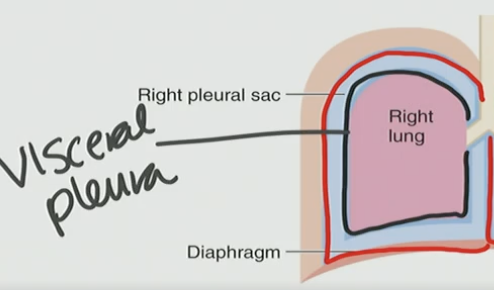

Which pleural layer lines the inner surface of the thoracic wall?
A. Visceral pleura
B. Parietal pleura
C. Alveolar pleura
D. Pulmonary membrane
B. Parietal pleura
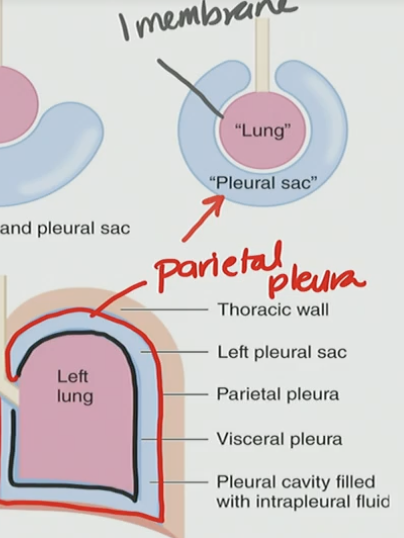
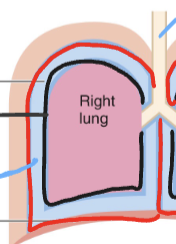
What lies between the visceral and parietal pleura?
A. Lymphatic duct
B. Bronchioles
C. Pleural cavity filled with fluid
D. Alveoli
C. Pleural cavity filled with fluid
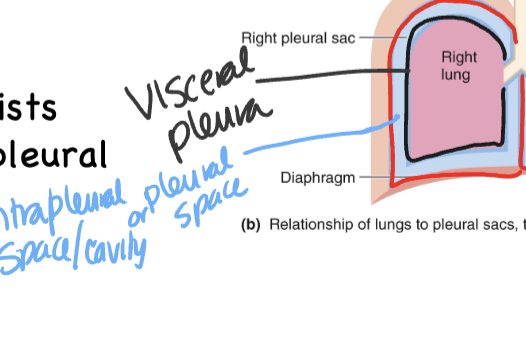
What is the function of the pleural fluid within the pleural cavity?
A. Prevents gas exchange between lungs and blood
B. Allows the lungs to slide smoothly during breathing
C. Traps pathogens entering the lung
D. Helps in surfactant production
B. Allows the lungs to slide smoothly during breathing
Which pleural membrane does not come into direct contact with the lung surface?
A. Visceral pleura
B. Inner pleura
C. Parietal pleura
D. Alveolar membrane
C. Parietal pleura
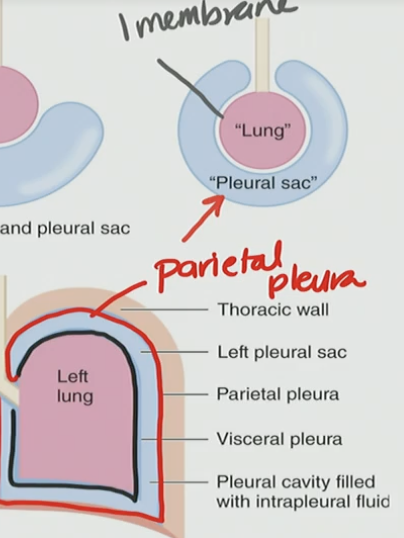
Which of the following best describes atmospheric pressure (Patm)?
A. The pressure inside the alveoli
B. The pressure within the pleural sac
C. The pressure exerted by the air in the environment
D. The pressure created by the diaphragm during inspiration
C. The pressure exerted by the air in the environment
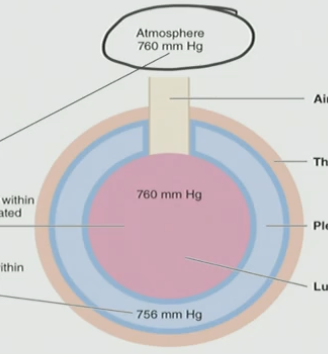
What is the approximate value of atmospheric pressure at sea level?
A. 756 mm Hg
B. 760 mm Hg
C. 500 mm Hg
D. 700 mm Hg
B. 760 mm Hg
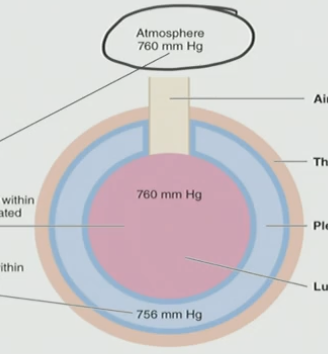
What is alveolar pressure (Palv)?
A. The pressure in the pleural cavity between the lungs and chest wall
B. The pressure within the trachea during inhalation
C. The pressure of air inside the alveoli of the lungs
D. The pressure outside the body at sea leve
C. The pressure of air inside the alveoli of the lungs
Where is alveolar pressure measured?
A. Inside the pleural sac
B. Outside the thoracic cavity
C. In the bloodstream
D. Inside the alveoli of the lungs
D. Inside the alveoli of the lungs
What primarily drives the movement of air into and out of the lungs?
A. Contraction of the trachea
B. Equal pressure between alveoli and atmosphere
C. Pressure gradients between the atmosphere and alveoli
D. Intrapleural pressure remaining constant
C. Pressure gradients between the atmosphere and alveoli
What best describes intrapleural pressure (Pip)?
A. The pressure inside the alveoli during inspiration
B. The pressure in the space between the visceral and parietal pleura
C. The pressure in the trachea during expiration
D. The pressure inside the diaphragm during contraction
B. The pressure in the space between the visceral and parietal pleura
Which of the following allows the lungs to expand during inspiration?
A. Air entering the intrapleural space
B. The negative pressure in the intrapleural cavity pulling the lungs outward
C. The contraction of the internal intercostal muscles
D. Increased pressure inside the alveoli
B. The negative pressure in the intrapleural cavity pulling the lungs outward
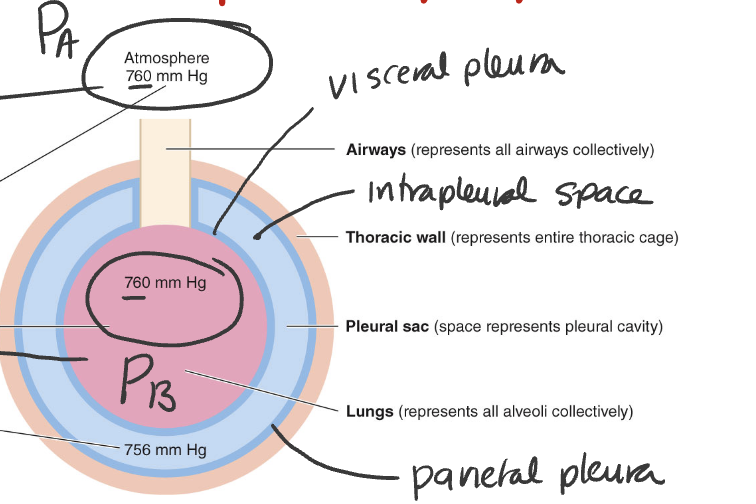
What is the value of alveolar pressure at the end of expiration?
A. 750 mm Hg
B. 756 mm Hg
C. 760 mm Hg
D. 765 mm Hg
C. 760 mm Hg
What is intrapleural pressure (Pip) typically at the end of expiration?
A. 750 mm Hg
B. 756 mm Hg
C. 760 mm Hg
D. 765 mm Hg
B. 756 mm Hg
Where is the intrapleural space located?
A. Inside the alveoli
B. Between the visceral and parietal pleura
C. Inside the diaphragm
D. In the bronchial tree
B. Between the visceral and parietal pleura
Which of the following are the three main pressures involved in driving ventilation (airflow)?
A. Pcap, Ppl, Phr
B. Pgas, Pven, Pthorax
C. Pip, Patm, Palv
D. Pbrain, Pheart, Pdiaphragm
C. Pip, Patm, Palv
What drives air flow in and out of the lungs?
A. Gravity
B. Pressure gradients
C. Surface tension of alveoli
D. Pleural fluid viscosity
B. Pressure gradients
What equation best describes air flow in the respiratory system?
A. Flow = R / ΔP
B. Flow = ΔP × R
C. Flow = ΔP / R
D. Flow = V × T
C. Flow = ΔP / R
When does air flow INTO the alveoli?
A. When Palv < Patm
B. When Palv = Patm
C. When Palv > Patm
D. When Pip = Palv
A. When Palv < Patm
What happens when alveolar pressure (Palv) is greater than atmospheric pressure (Patm)?
A. Air flows into the alveoli
B. Airflow stops
C. The diaphragm contracts
D. Air flows out of the alveoli
D. Air flows out of the alveoli
What law explains how changes in volume affect alveolar pressure?
A. Dalton’s Law
B. Henry’s Law
C. Boyle’s Law
D. Charles’ Law
C. Boyle’s Law
What principle is represented by the equation P × V = constant?
A. Dalton’s Law of Partial Pressures
B. Boyle’s Law
C. Henry’s Law
D. Charles’s Law
B. Boyle’s Law
According to Boyle’s Law, what happens to pressure if lung volume increases (and all else stays constant)?
A. Pressure increases
B. Pressure stays the same
C. Pressure decreases
D. Pressure equals intrapleural pressure
C. Pressure decreases
What best describes the lung’s natural elasticity?
A. Like a balloon
B. Like a rubber band
C. Like a steel spring
D. Like a sponge
B. Like a rubber band
recoils
According to Boyle's Law, what happens to the pressure of a gas if the volume of its container increases (assuming temperature and amount of gas stay constant)?
A. Pressure increases
B. Pressure decreases
C. Pressure stays the same
D. Pressure becomes zero
B. Pressure decreases
What effect does lung recoil have on alveolar pressure?
A. Lowers it
B. Keeps it constant
C. Raises it
D. Has no effect
During expiration, what happens to alveolar pressure (Palv)?
A. Drops below atmospheric pressure
B. Equals intrapleural pressure
C. Becomes greater than atmospheric pressure
D. Stays exactly 760 mmHg
C. Becomes greater than atmospheric pressure
The thoracic cavity volume decreases
So, the volume of the alveoli (lung sacs) also decreases
This makes the pressure inside the alveoli
In order to exhale, what must happen to the pressure inside the alveoli Palv relative to atmospheric pressure Patm?
A. Alveolar pressure must be lower than atmospheric pressure
B. Alveolar pressure must equal atmospheric pressure
C. Alveolar pressure must be higher than atmospheric pressure
D. Atmospheric pressure must rise above alveolar pressure
C. Alveolar pressure must be higher than atmospheric pressure
During inspiration, air flows into the lungs because:
A. Palv > Patm
B. Palv < Patm
C. Palv = Patm
D. Intrapleural pressure exceeds alveolar pressure
B. Palv < Patm
What happens to alveolar pressure (Palv) when the lungs expand during inspiration?
A. It increases above atmospheric pressure
B. It becomes equal to atmospheric pressure
C. It decreases below atmospheric pressure
D. It becomes zero
C. It decreases below atmospheric pressure
Which of the following causes lung volume to increase during inspiration?
A. Relaxation of respiratory muscles
B. Contraction of respiratory muscles
C. Increase in alveolar pressure
D. Collapse of the pleural sac
B. Contraction of respiratory muscles
Inspiration is active and requires muscle contraction (e.g. diaphragm, external intercostals).
What pressure change causes air to move into the lungs?
A. Increase in Patm
B. Increase in intrapleural pressure
C. Drop in alveolar pressure
D. Increase in lung elastic recoil
C. Drop in alveolar pressure
Boyle’s Law — as volume increases, pressure decreases, letting air rush in.
What happens to alveolar pressure (Palv) at the end of inhalation when the lungs have fully expanded?
A) It becomes higher than atmospheric pressure.
B) It becomes lower than atmospheric pressure.
C) It equals atmospheric pressure.
D) It becomes zero.
C) It equals atmospheric pressure.
At the end of a quiet inhalation, no more air is flowing in or out, which means the alveolar pressure is equal to atmospheric pressure. This is the point of pressure equilibrium.
What causes the alveolar pressure (Palv) to increase after inhalation?
A) Contraction of the diaphragm.
B) Expansion of the chest cavity.
C) Relaxation of the diaphragm and elastic recoil of the lungs.
D) Increase in blood flow.
C) Relaxation of the diaphragm and elastic recoil of the lungs.
During exhalation, why does air flow out of the lungs?
A) Because alveolar pressure is lower than atmospheric pressure.
B) Because alveolar pressure is higher than atmospheric pressure.
C) Because the diaphragm contracts.
D) Because the lungs are expanding.
B) Because alveolar pressure is higher than atmospheric pressure.
What primarily causes the lungs to recoil after inhalation?
A) Contraction of the intercostal muscles.
B) Elastic properties of the lung tissue.
C) Increase in blood pressure.
D) Expansion of the alveoli.
B) Elastic properties of the lung tissue.
What happens to alveolar pressure when the diaphragm relaxes?
A) It decreases, allowing more air in.
B) It increases, pushing air out.
C) It remains the same.
D) It becomes zero.
B) It increases, pushing air out.